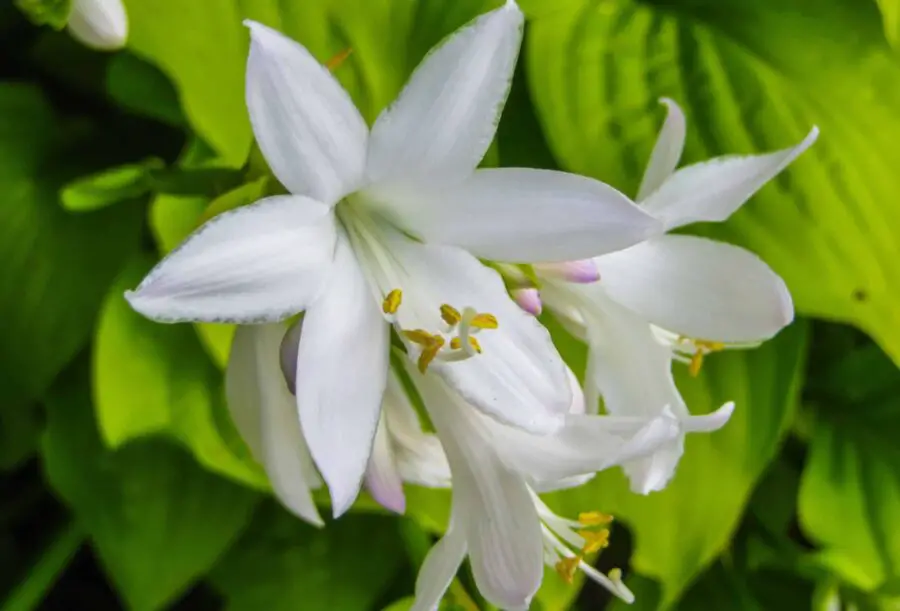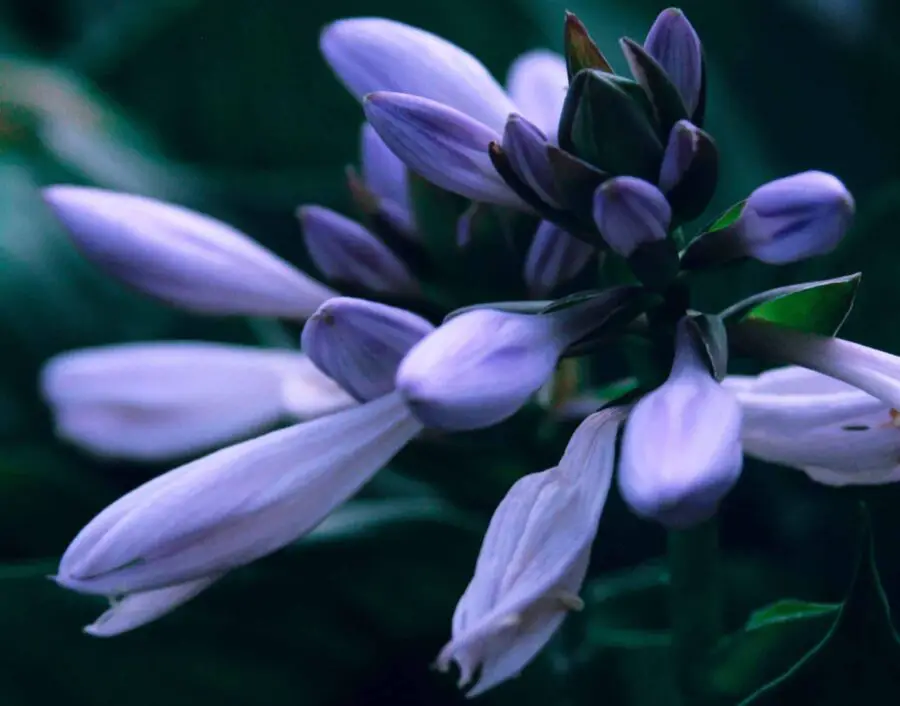As a hosta lover, I cannot imagine not having a few fragrant varieties growing in my garden and even in pots inside my home. Fragrant hostas are a treat for any hosta lover as they are not only beautiful, but they have lovely fragrant blooms to match.
Fragrant hostas are versatile, hardy, and easy-to-grow plants that will grow in many spaces where other varieties won’t flourish. To produce uniquely fragrant blooms, we should plant them in sunny areas with four to six hours of sunlight daily.
All hostas are a treat in any garden because of their attractive foliage and beautiful colors, but not all hostas are fragrant. Fragrant hostas are just as beautiful as any hosta variety but, each one has an extraordinary fragrance to match their beauty.
Where Does The Fragrance In Hostas Come From
When growers talk about fragrance in hostas, it always seems to revolve around how strong is the fragrance in this or that hosta.
But the other question I don’t hear often is what a hosta smells like. The most common response is they have a honeysuckle like smell. Others say they smell like a gardenia or narcissus. Most hostas have similar fragrance, however they are not all the same.
Not all fragrant hostas have strong scents, we can divide hosta fragrances into two distinct fragrance classes:
All fragrant hostas can trace their lineage back to the Hosta plantaginea. H. plantaginea is unique not only for bearing fragrant flowers, it is one of only four hosta species that originated in China, not Korea or Japan, like most of the Hosta family.
The first H. plantaginea was imported into England in 1790 (some say a few years earlier) and the U.S.A. in the 1830s.

The distinct plantaginea fragrance is attributed to the high emissions of a naturally occurring compound known as linalool.
The compound linalool is a natural camphor powder or camphor essential oil that is used as a scent in around 60% to 80% of our everyday cleaning products and scented personal hygiene products.
We know that Linalool is a monoterpene alcohol that has antifungal and antimicrobial properties. You would think that the scent might be unbearable, but the opposite is true!
We define linalool as a character impact compound that causes lavender to have its floral scent. It is also one compound that gives green and roasted coffees their wonderful aroma!
Linalool together with myrcene, limonene and ocimene are the compounds responsible for the floral-scented aromas from hosta plants.
Why Grow a Fragrant Hosta?
While all fragrant hostas can trace their lineage back to the Hosta plantaginea, hybrids and sports now exist that are more dependable but can still produce the same wonderful fragrances.
The new varieties have leaves with green, yellow, white, and blue shades and many variegated patterns, and beautifully scented flowers—the perfect plant to grow in any space.
As with all hostas, the fragrant varieties are easy to grow, and they don’t need too much maintenance. Hostas are drought tolerant and will thrive in most conditions as long as they have good organic, moist soil.
They are versatile in any garden, and may be planted in containers or directly into the ground or even indoors.
Fragrant hostas are great for cutting and using as fresh bouquet flowers. Hosta flowers will last for up to three weeks in a vase of water, giving you the benefit of their wonderful aroma around your house!
When Do Most Fragrant Hostas Bloom
The Hosta plantaginea hails from the southern part of China, where spring arrives early, and the summer months are hot and humid. In the US, the dormant period of most fragrant hostas ends early, around March of each year.
This means that the plant is susceptible to late freezes and frosts, and young plants could succumb to the frost.
H. plantaginea and some of its offspring can produce new beautiful foliage during the growing season, unlike most hostas, creating an eye-catching plant throughout the summer months.
The beautiful trumpet-looking flowers will start to appear late into the summer and some continue into the early autumn. They will look their best from around July to October.

Most of the hosta hybrids flower for around three weeks, from late April through June each year. So when they are looking tired in the middle of summer, fragrant hostas will start showing their beautiful flowers, adding wonderful color and fragrance to your garden.
These fragrant flowers open in the late afternoon. Their fragrance fills the evening air, ready to greet you after a long day at work. Open your windows to drink in the rich scent!
With all the work being done to produce more and better fragrant hostas, it has blurred the above timelines a bit with earlier bloom times for some hybrids.
How Much Sunlight do Fragrant Hostas Need
With Hosta plantaginea originating in southern China, it can handle more sun than most Hosta varieties.
Many of the hostas in the plantaginea family need a surprising amount of exposure to the sun for their flowers to develop. I often recommend four to six hours of sun for these hostas.
Despite these plants needing lots of sunlight, you can still damage the plant by exposing it to the direct sun in the hottest part of the day. This is especially true in the hotter climates. Also, keep plants well watered.
The Best Fragrant Hostas
While there are many varieties of hostas with fragrance, here is a short list of some popular varieties.
Fragrant Blue
While on many lists of fragrant hostas, this cultivar may disappoint you regarding fragrance. Many can’t smell any fragrance and other say they detect just a hint. This is a nice hosta, but buying one for fragrance could be a disappointment.
Stained Glass
Big bright gold leaves with deep green margins. Good fragrance, very reliable. This hosta will reach a height of about 15 inches by 36 inches wide. An excellent choice.
Fragrant Bouquet
A broad apple-green leaf with creamy margins and nicely fragrant white flowers with a hint of lavender. Grows to a height of 18 inches by 36+ inches wide.
Ambrosia
Leaves with light yellow centers and bluish margins. It will reach a height of 24 inches and a width of 54 inches. Outstanding.
H. plantaginea
A magnificent plant. Can be disappointing if you cannot provide the long hot summers it needs. Me, I would still try it no matter where I lived. Will grow to about 25 inches tall and 55 inches wide when mature.
Related Questions
Why Are My Fragrant Hostas Not Flowering
Fragrant Hostas need to be planted in a less shady area to produce flowers. If they are in an area that is in the shade most of the day, they will not flower. Although most Hostas are shade lovers, many of these hostas need more sunlight to thrive and produce flowers.
Are all Hostas Fragrant
There are over 70 species of Hostas with over 3000 registered varieties (cultivars). Of these, only H. plantaginea and some hybrids and sports produce fragrant flowers. Still, there are over 200 varieties that are fragrant.
Closing Thoughts
A garden or potted plant area filled with fragrant hostas can turn any secluded space into a dream getaway or an out-of-the-way space into a wonderfully aromatic and colorful, easy-to-maintain space.
Place fragrant hostas close to your home or next to often-used areas in your garden so that you can enjoy the full aromas of these beautiful plants when they flower.
There are so many wonderfully fragrant varieties available, so do the research on what would be best for your garden before buying.
